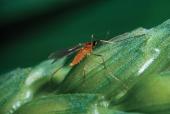
Agricultural insect pests are a diverse group: they include herbivores, stored grain pests, and livestock pests. There are also insects that act as vectors of disease organisms. The primary factors that influence insect population growth include weather (temperature, moisture and wind), food supply, availability of habitat, and natural enemies. Many pest insects are invasive species that have been introduced into Canada from other countries, especially Europe. However, some of our most chronic pests are native to the Canadian prairies. Although there has been an increase in the area seeded to oilseed and pulse crops in Saskatchewan, cereal crops still dominate. There are some twenty species of insect pests that attack cereal crops; the predominant species, and those most frequently in need of control, are grasshoppers and wheat midge. Other pests include wireworms, cutworms, wheat stem sawfly, and aphids.
Of the seventy or so grasshopper species native to Saskatchewan, there are only a small number (a few Melanoplus species) that are of economic importance to crop production. The occurrence and distribution of these species are generally associated with the grassland ecozones in Saskatchewan, although isolated outbreaks can also occur in the parkland ecozone where the soil is lighter in texture. Grasshoppers remain a chronic pest problem in the province primarily because they are so well adapted to conditions on the Canadian prairies. Most species overwinter as eggs in the soil, insulated by snow cover. Grasshoppers emerge in spring in response to temperature; higher temperatures result in faster development of the eggs and nymphal growth. Hot, dry weather conditions favour population increase, while cool moist conditions slow population growth. Although there is a guild of natural enemies (predators, parasites, diseases), they generally do not reduce grasshopper populations sufficiently during outbreaks.
Wheat midge, Sitodiplosis mosellana, is native to Europe. Since it was discovered in Saskatchewan in 1983, the insect has spread to most of the wheat-growing areas of the prairies. Larvae feed on developing wheat kernels, reducing grain yield and quality. At low levels, wheat midge populations may go unnoticed for several years; however, under favourable conditions, these populations can reach epidemic levels within one or two years. Moist conditions in May and June favour larval development and emergence of adults; warm, calm conditions in July favour egg-laying. There is one natural enemy, the pteromalid wasp Macroglenes penetrans, that plays a significant role (30% to 40%) in reducing wheat midge infestations. Other pest management practices include rotating wheat with resistant crops (oilseeds or pulses) to discourage buildup of wheat midge populations.
Saskatchewan produces a major share of oilseed crops in the prairie region. This shift away from cereal crops has also been accompanied by a change in the insect pest complex of prairie field crops. Some thirty species of insect pests attack oilseed crops; the predominant species are flea beetles and bertha armyworm. Other pests include diamondback moth, root maggots, red turnip beetle, plant bugs, red-backed cutworm, beet webworm, cabbage looper, imported cabbageworm, and painted lady butterfly.
Eight flea beetle species are known to damage canola, mustard and rapeseed crops. However, only the crucifer flea beetle, Phyllotreta cruciferae, and the striped flea beetle, P. striolata, are economically important. Both species were introduced into Canada from Eurasia. Adult beetles overwinter in plant litter, become active early in spring, and cause severe damage to newly emerging crops. Planting oilseed crops early and using large seeds to maximize seedling vigour produces plants that can tolerate flea beetle injury. Natural enemies do not significantly suppress flea beetle populations.
Bertha armyworm (Mamestra configurata), a type of climbing cutworm, is native to North America. Severe infestations on oilseed crops can occur throughout Saskatchewan, but they occur more frequently in the parkland ecozone. The adult emerges in early summer and is strongly attracted to its host plants when they are in bloom. The larvae mature rapidly and cause severe damage in the last two larval stages. In most years, bertha armyworm populations are suppressed by unfavourable weather conditions and by natural enemies, which include a nuclear polyhedrosis virus, an ichneumonid wasp, and a tachinid fly. However, when these natural regulators fail, populations tend to increase dramatically in just a few seasons.
As the dominant land animals, it is not surprising that some insects have a negative impact on agricultural production. However, it has been estimated that insects that function as decomposers, pollinators, predators and parasites, provide five to ten times more benefits to agricultural production than the damage caused by pest species.
Owen Olfert